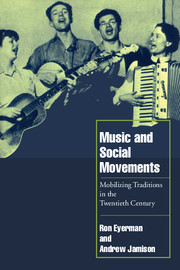Book contents
- Frontmatter
- Contents
- Acknowledgments
- Introduction
- 1 On social movements and culture
- 2 Taking traditions seriously
- 3 Making an alternative popular culture: from populism to the popular front
- 4 The movements of black music: from the New Negro to civil rights
- 5 Politics and music in the 1960s
- 6 From the sixties to the nineties: the case of Sweden
- 7 Structures of feeling and cognitive praxis
- Notes
- Bibliography
- Index
6 - From the sixties to the nineties: the case of Sweden
Published online by Cambridge University Press: 26 October 2011
- Frontmatter
- Contents
- Acknowledgments
- Introduction
- 1 On social movements and culture
- 2 Taking traditions seriously
- 3 Making an alternative popular culture: from populism to the popular front
- 4 The movements of black music: from the New Negro to civil rights
- 5 Politics and music in the 1960s
- 6 From the sixties to the nineties: the case of Sweden
- 7 Structures of feeling and cognitive praxis
- Notes
- Bibliography
- Index
Summary
When people ask me if I really think that songs can affect political developments in society I usually answer that I see culture as the substance of politics. I mean that culture (songs, for example) gives expression to what we think and feel, what we dream and long for, and what we are ready to fight for. And that is exactly what politics is about.
Mikael Wiehe (1980: 11–12)The politically charged music of the 1960s has been diffused during the past thirty years in a variety of ways. On the one hand, there has been a process of globalization by which American music has entered into, and in large measure served to define, a worldwide culture industry. From the end of the 1960s, rock music has come to exert an enormous influence over international popular culture, and, in economic and financial terms, has become one of the major commercial activities in the world. Rock music has stimulated developments in technology – from synthesizers to CDs, from electric guitars to the Internet – as well as in other leisure and consumer industries, and it has become a crucial ingredient in many other areas of culture, from film and theater to art and advertising.
As a result of these multifarious processes of diffusion, the music has, of course, been continuously depoliticized: the trajectory that was already visible in the sixties, from political folk music to harmless rock music, and from songwriting “movement intellectuals” to individualized rock artists, has become a kind of norm.
- Type
- Chapter
- Information
- Music and Social MovementsMobilizing Traditions in the Twentieth Century, pp. 140 - 159Publisher: Cambridge University PressPrint publication year: 1998

